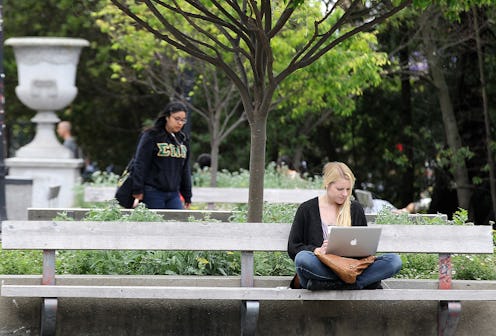News
More Than A Third Of College Students Go Days Without Eating — Here’s Why

The "Freshman 15" usually refers to pounds that students, suddenly free of the confines and controls of their parents homes, gain — but lately, it appears as though there's an actually dangerous food-related problem on college campuses. A new study from Temple University and the Wisconsin HOPE Lab has just shown that 36 percent of college students are going hungry — and a similar percentage don't have a stable living situation.
"Hungry" and "homeless" aren't necessarily terms you'd automatically associate with college students, given the sometimes lavish food courts and luxurious dorm living that universities like to advertise — but according to this study, that perception should probably start changing.
For the study, HOPE Lab looked at 43,000 students at 66 places of higher learning, including four-year colleges and universities in addition to community colleges, in 20 states and the District of Columbia.
The results showed that 36 percent of students at universities had experienced food insecurity in the month before the study, and the numbers were even worse for students at community colleges, where 42 percent reported the same thing. The housing insecurity numbers are similar, at 36 percent for university students and 46 percent for community college students. Additionally, 9 percent of university students reported having been homeless at some point in the past year, as did 12 percent of community college students.
The reasons behind what researchers believe is a growing problem at colleges and universities are manifold. Colleges are getting more expensive, for one thing, but it doesn't stop there. Financial aid packages just aren't always enough for struggling students, and this issue disproportionately affects the rising numbers of low-income students enrolling in higher education. Universities have been admitting and enrolling students from lower income backgrounds, but theWashington Post explained that this hasn't always come along with changes to the policies that affect these students financially.
"Prices have gone up over time," Sara Goldrick-Rab, a Temple University higher education policy professor who is also the report's lead author, told the Washington Post. "But the rising price is just a piece. This is a systemic problem."
While this study is the first to take so many students and institutions into account, similar studies on smaller scales show similar results. A study of the University of California system found that 42 percent of students across 10 campuses had experienced food insecurity, and 35 percent of respondents in a study across four Illinois University campuses reported the same thing.
When students don't know where their next meal is coming from, it naturally affects their performance in school. After all, they have the same academic and extracurricular demands on their shoulders as all of the other students do, but they've got this additional stressor — and it's a significant one. HuffPost reported that a previous study on the subject found that food insecurity was connected to “poorer health, poor academic performance, and mental health symptoms such as depression and anxiety.”
The Washington Post spoke with a number of students experiencing food insecurity themselves, and the decisions they're facing on a daily basis are almost hard to comprehend in the face of the stereotype of the spoiled college student.
“I’m not going hungry per se, but there are days I’m just not going to eat,” George Washington University sophomore Emma Montero told the Washington Post. In addition to a number of grants, scholarships, and low-interest loans, Montero also works three jobs.
There are ways that schools have begun to deal with this problem, including opening food pantries for students who need them or, as the AP reported, partnering with organizations to offer food scholarships. There's a ways to go — but visibility is at least a start.